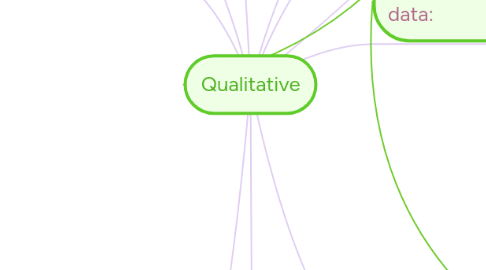
1. 2. Observations
1.1. Aim to describe behavior without trying to establish C&E relationships.
1.1.1. most take place in a natural setting ( Naturalistic Observation ), but they can take place in laboratories
1.1.1.1. raw data can be visual (video), audio (tape recording), or written, ( notes, ratings, etc.)
1.2. Challenges in Observations
1.2.1. impossible to record
1.2.1.1. Researcher Bias - should not be affected by what the researcher expects to find The solution is inter-observer reliability - having several researchers observe the same thing to make sure what is written actually happened
1.3. Participant
1.3.1. Researcher becomes part of the group attempts to feel what it is like to be in that social situation, not just look at it
1.3.1.1. There is a choice between covert and overt observation (important)
1.4. Non-Participant
1.4.1. the researcher is not part of the group that is being observed
1.4.1.1. Possible Issues: Reactivity, Demand characteristics, Researcher bias
1.4.1.1.1. Researchers want the participants to act as they normally would, however, people will change their behavior when they are observed, that is called reactivity.
1.5. Cover observation : when participants don’t know they are being observed
1.5.1. Overt observations : participants know they are being observed
2. There is no cause-and-effect. It seeks to describe the meaning attributed to events by the research participants.
3. asks a question, gathers data, and then analyzes it for meaning… This means it is inductive.
4. The interest of the qualitative researcher is how people explain their everyday experiences The aim of qualitative research is to get insights into physiological processes
4.1. not fueled by a hypothesis, but the research question guides the research.
5. Ethics still exist.
6. 3. Case Studies
6.1. Grounded in real life Produces rich data that can provide insight into unique phenomena or an individuals behavior
6.1.1. Focuses on a limited aspect of behavior, like becoming a parent Researcher observes the behavior of an individual or a group of individuals Descriptions of people’s experiences, feelings, or thoughts about a topic
6.2. Allows investigation of a topic in far more detail Allows for investigation of human experience that cannot be investigated with other research methods.
6.2.1. Use of # data collection methods to generate material suitable for analysis : - qualitative techniques (interviews, obs) - personal artifacts (letters, diaries) - official documents (notes, appraisals)
6.3. Using multiple methods of investigation to explore the same topic is called triangulation
6.3.1. Important because they may highlight extraordinary behavior and stimulate new research. Also, can contradict existing beliefs
6.4. The finding of a case study cannot be replicated because each case is unique That makes reliability low
6.4.1. generally not possible to generate results to the general population If more case studies corroborate the findings, some generalization might be possible
7. 1. Interviews
7.1. interview schedule-a plan for conducting the interview,
7.1.1. interviewer effects: responses be the interviewee to the attitude, behavior, ago, sex, race/ethnicity, etc. of the interviewers
7.2. Structured:
7.2.1. Interview scheduled may state the exact question to be asked in their order. The procedure is highly questionnaire, but there may be guidance from the interviewer.
7.2.1.1. data is easy to analyse and compare
7.2.1.1.1. may seem artificial since it is so tightly controlled
7.3. Unstructured:
7.3.1. Interview schedule only specifies topic and available time Open to the interests and motivation of the interviewee
7.3.1.1. Interviewee can reveal more about themselves
7.3.1.1.1. Thus data is more difficult to analyse
7.4. Semi-Structured:
7.4.1. schedule includes a set of questions, but permits interviewee to respond freely with more focus
7.4.1.1. Some questions are closed (one word answers, choice)
7.4.1.1.1. Some questions are open ended
